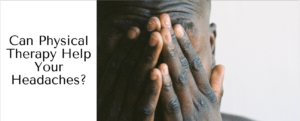Can Physical Therapy Help Your Headache?
Headaches are a common complaint in the United States and there is no shortage of advertised treatments including medications, medical devices, Cognitive Behavioral Therapy, acupuncture, meditation, oral appliances, manual medicine, supplements, among the more common. With so many options available, it can be overwhelming to figure out what treatment direction to pursue. A physical therapist can help! There is growing literature that migraine, tension type headaches and headaches referred from the neck (cervicogenic) may be driven, in part, by posture and knots in the muscles(ie trigger points) of the head, neck and jaw.
Key Anatomy That Drive Headaches
There are several structures in the neck that can refer pain up into the head including joint irritation from the first three neck vertebrae, nerve irritability, and trigger points, or “knots” in several neck muscles, along with referred pain from the jaw. Your physical therapist can assess all of these possible pain generators and create an individualized program to address your particular problems.
Signs That You Need a Physical Therapist
Some signs that physical therapy may benefit you include neck pain or stiffness that proceeds or exacerbates you headache, pain in the back of the head or temple (can spread to other areas), headache onset after an injury (e.g. car accident or concussion), feeling of muscle tension or stiff neck, and clicking or grinding of your jaw.
Three Interventions to Start Helping Your Headaches Today
1. Posture
While research shows that poor posture may not cause
headaches to develop, poor posture can perpetuate headaches. Poor posture can be in response to an injury or pain. So your first step is to work on your posture! When in sitting, your ear should line up with your shoulder and your shoulder should line up with your hips. Another basic step is to work on your sleep.
2. Sleep
Did you know that poor sleep habits can contribute to your pain? It is true! There is a strong link between poor sleep and pain complaints. You can start to remedy this by making sure that you stay on a sleep schedule. This means going to bed when you are tired and waking up at the same time every day. There is evidence that you cannot “catch up” on sleep on the weekends so treat yourself right and make sure you get at least 6-7 hours of sleep a night.
3. Targeted Strengthening
The last basic step is to work on your neck strength. Evidence links weakness of deep muscles in the front of your neck with a variety of headache types. To work on strengthening these muscles, perform a chin tuck. There are a variety of tutorials out there showing how to correctly perform this, but the basic movement is to move the head backwards like you are making a double chin. The movement should be gentle enough that your whole neck doesn’t tighten up. I typically tell patients to hold this position for 5-10 seconds and repeat 10 times.
Of course, the above recommendations are general suggestions that almost anyone can benefit from, but they do not replace the advice of a medical professional.
This post was written by Dr. Sara Etheredge. Dr. Etheredge has extensive experience working with patients to get their headaches under control . Check out her bio here to learn more about Dr. Etheredge.
